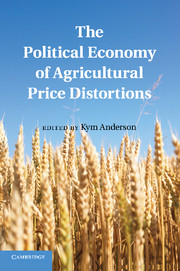Book contents
- Frontmatter
- Contents
- List of Figures
- List of Tables
- Contributors
- Foreword
- Preface
- Abbreviations and Acronyms
- PART ONE Introduction
- PART TWO CONCEPTUAL FRAMEWORKS AND HISTORICAL ORIGINS
- THREE Political Economy of Agricultural Distortions
- FOUR Special Interests versus the Public Interest in Policy Determination
- FIVE Anglo-French Trade, 1689–1899
- SIX Agricultural Protection Growth in Europe, 1870–1969
- SEVEN Determinants of United States Farm Policies
- EIGHT Agricultural Distortions in the Transition Economies of Asia and Europe
- Part Three Political Econometrics: the Past Fifty Years
- Appendix: Coverage and Distribution of Assistance across Countries and Products, 1955–2007
- Index
- References
THREE - Political Economy of Agricultural Distortions
The Literature to Date
Published online by Cambridge University Press: 05 July 2011
- Frontmatter
- Contents
- List of Figures
- List of Tables
- Contributors
- Foreword
- Preface
- Abbreviations and Acronyms
- PART ONE Introduction
- PART TWO CONCEPTUAL FRAMEWORKS AND HISTORICAL ORIGINS
- THREE Political Economy of Agricultural Distortions
- FOUR Special Interests versus the Public Interest in Policy Determination
- FIVE Anglo-French Trade, 1689–1899
- SIX Agricultural Protection Growth in Europe, 1870–1969
- SEVEN Determinants of United States Farm Policies
- EIGHT Agricultural Distortions in the Transition Economies of Asia and Europe
- Part Three Political Econometrics: the Past Fifty Years
- Appendix: Coverage and Distribution of Assistance across Countries and Products, 1955–2007
- Index
- References
Summary
The 1980s and the first half of the 1990s were a very active period in the field of political economy of agricultural protection and distortions. The research was triggered by a combination of factors. First and foremost, there was the puzzling question: Why was agriculture supported in rich countries and taxed in poor countries? Second, emerging general theories of “new political economy” were coming out from the University of Chicago with the important contributions of Stigler (1971), Peltzman (1976) and Becker (1983), from the public choice school by Buchanan and Tullock (1962), and from the influential work by Downs (1957) and Olson (1965). A third factor was the arrival of new data, in particular the developing country dataset assembled as part of the World Bank study organized by Krueger, Schiff and Valdés (1988, 1991) and the high-income dataset compiled by Anderson, Hayami and Others (1986). The combination of an intriguing question, a rich set of new general theories to apply, and fascinating data induced a rich and vast literature on the political economy of agricultural distortions in the 1980s and the first part of the 1990s, with important contributions by, among others, Kym Anderson, Robert Bates, Harry de Gorter, Bruce Gardner, Yujiro Hayami, and Gordon Rausser. In our chapter for the Handbook of Agricultural Economics, Harry de Gorter and I reviewed most of this empirical and theoretical literature on the political economy of agricultural economics (de Gorter and Swinnen 2002).
- Type
- Chapter
- Information
- The Political Economy of Agricultural Price Distortions , pp. 81 - 104Publisher: Cambridge University PressPrint publication year: 2010
References
- 9
- Cited by



